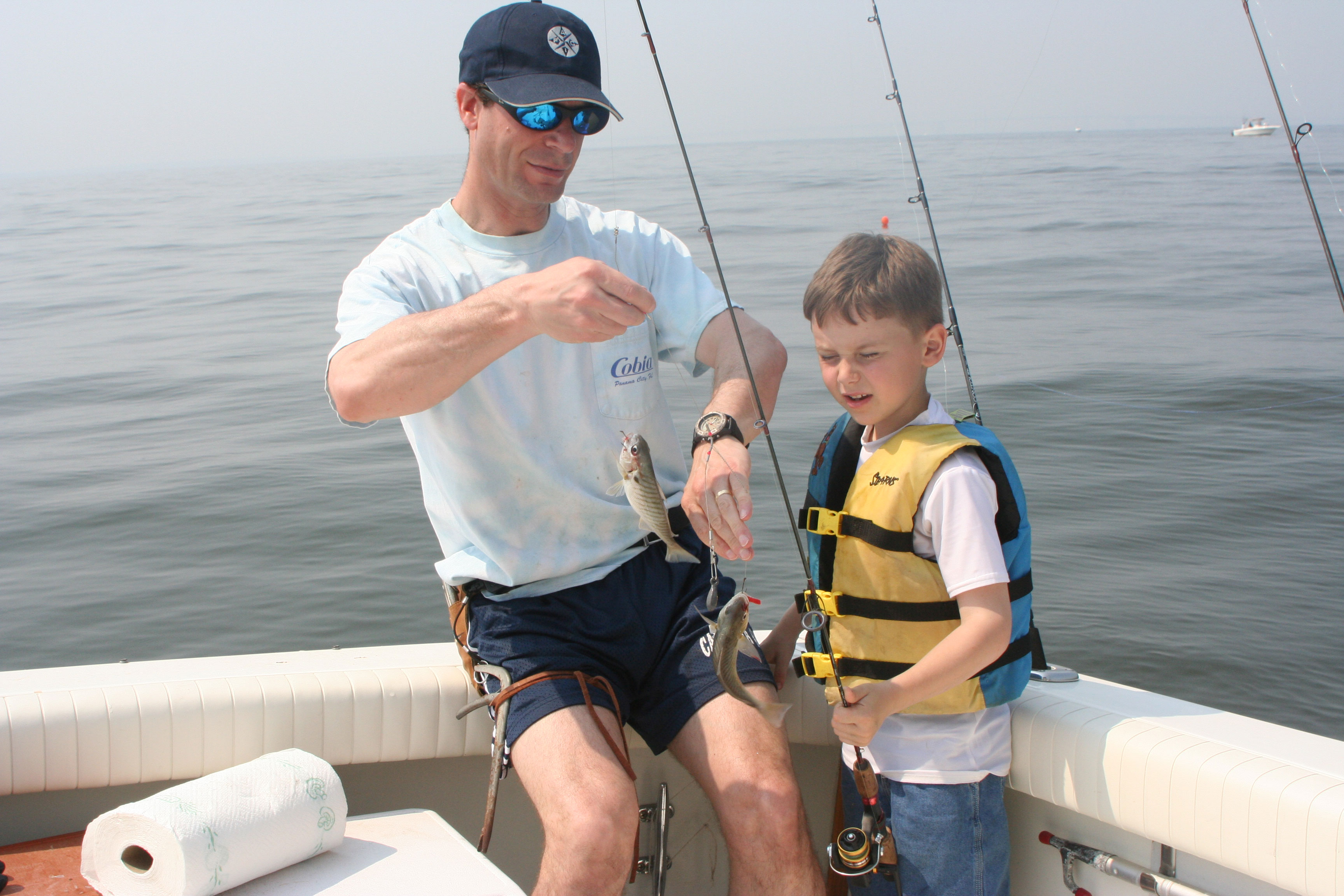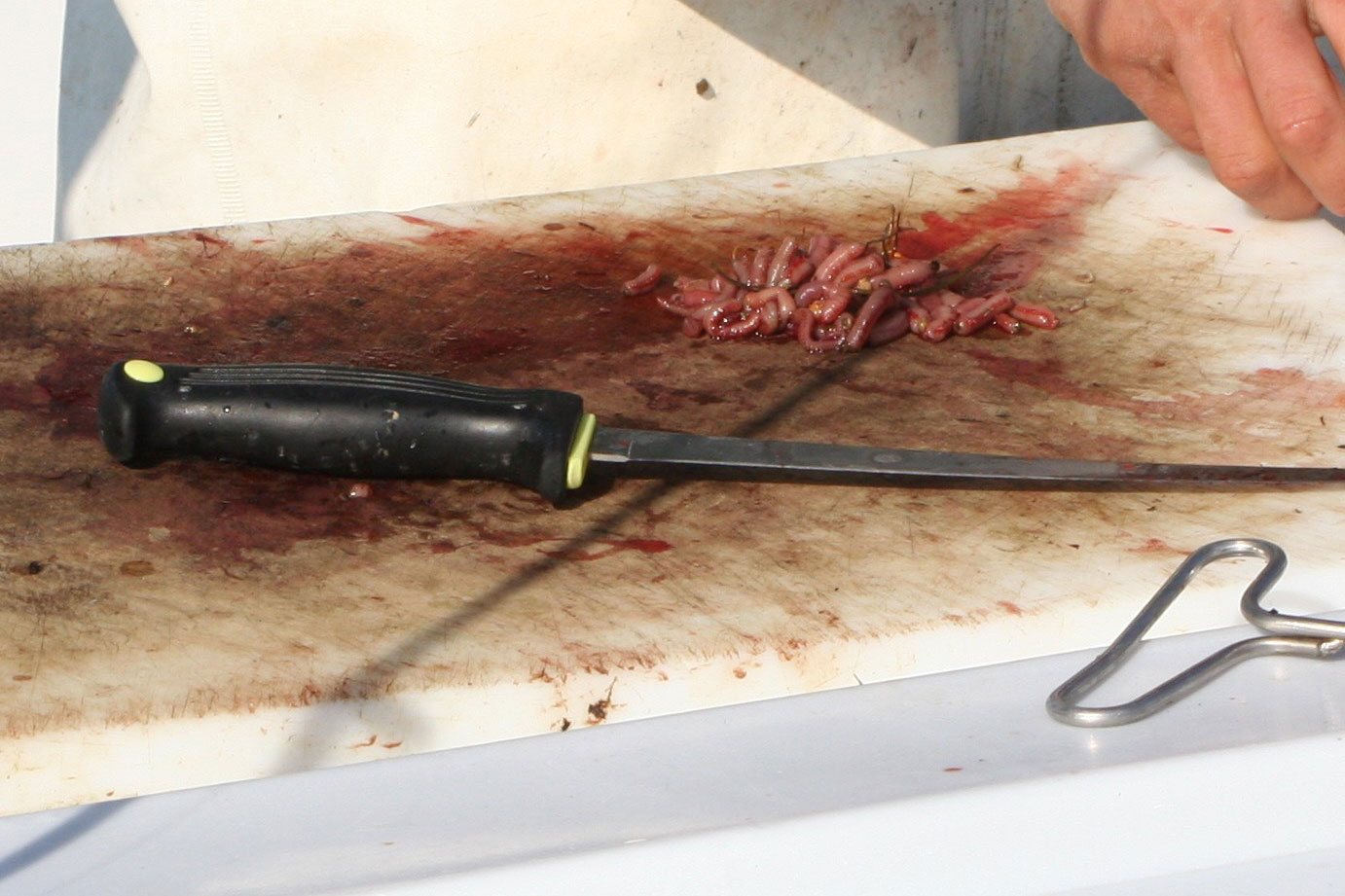Live lining with spot is highly effective, when you’re trying to put striped bass in the cooler. Most of the time if you drop this “rockfish candy” over the side, stripers will pounce right on them. As a result, this has become an incredibly popular way to fish for striped bass. And next month in Part II we’ll address the best way to live-line spot, and then the best areas to try it in. This month, however, we’re going to focus on the spot themselves—because quite often, the toughest part of live-lining for rockfish with spot is catching those spot in the first place.

The Bottom Rig
The most important item in your spot-catching arsenal is the bottom rig. The size of your rod, reel, and main line is essentially irrelevant, just as long as there’s a standard-issue two-hook bottom rig attached at the end. Also important, however, is that the hooks be extremely small. A four inch spot is an ideal bait, and fish this small will have a tough time chomping on a #4 hook; #6 is ideal, and while #8 is on the small side, it isn’t too small. There’s no need to get fancy, either. Circle hooks aren’t necessary (and can be problematic, since just about every angler on the face of the planet wants to swing for the stars when they feel the jack-hammer strike of a spot), long shanks are detrimental, and color rarely if ever makes a difference. If I had to pick the perfect spot hook, it would be the Eagle Claw 139S #6 snelled hook, which has bait-holder barbs on the shank (to help keep the bait bits in place) and a pre-rigged leader with a loop on the end.
With the pre-tied leader, rigging the hooks to the bottom rig is a piece of cake. But if you attach them directly to the loops at the ends of the rig arms the leader will be a bit too long, and the hooks may tangle with each other. Instead, first run the hook through the gap at the base of the rig arm, then through the loop at the end of the wire arm, then through the leader’s loop, and finally pull it tight. You’ll end up with about three inches of line between the rig arm and the hook, which is ideal. One final word when it comes to rigging for spot: though it may seem obvious, remember to use enough weight to keep that rig right down on bottom.
No Debate About Bait
Truth be told, spot will eat just about anything. Clam snout, grass shrimp, bits of soft crab—if it’s small enough for the spot to choke it down, they’ll usually bite to one degree or another. That said, bloodworms are the hands-down best bait for this species. Yes, yes, I know—a bag of bloodworms cost as much as a pair of “whale” soft crabs, two bags of GULP Jerk Shad, three gallons of gas, or dinner at Chick-Fil-A. Get over it. Pry the cash out of your wallet and buy those bloodworms, because spot love to eat them just as much as the rockfish love to eat the spot. Plus, they stay on the hook well (especially when you’re using hooks with the aforementioned bait-holder barbs) and if you treat them right you’ll get a couple of trips out of one bag (that means putting them in the refrigerator despite the protests of your better half, and flipping the bag over once a day, every day).

Now that we’ve harped on the importance of buying bloodworms despite their high cost, we’ve got more financial bad news: you also need to pick up a bag of Fishbites. These artificial bloodworms work as good as the real thing at times, and maybe half as well at other times. They don’t make a mess, a single chunk lasts through being chewed on by several fish, and you can stow them and forget them for a year or two and they’ll still work just fine. That last trait is why we think everyone should have a bag aboard their boat. Sometimes you get bad (read: old) bloodworms, and sometimes bait-stealers rip through your supply. Tossing a bag of Fishbites into your tacklebox at the beginning of the season gives you a perpetual spot fishing back-up plan.
The biggest mistake you’ll see people make when using bloodworms for spot, or any bait for that matter, is over-baiting the hook. Cut an inch-long chunk, and it’ll completely cover a #6 hook and then some. As a result you’ll miss lots of hits, as fish grab the long chunk of worm from all different directions and rip it from the hook. Instead, use a piece just long enough to run from the hook point to the bait-holder barb, about half an inch long. That’s small enough for the spot to inhale whole, and most of the strikes will lead to solid hook-ups.
Spot Fishing Locations
If your rigging is right and your bait is bloodworm bits, the next big question is where you’ll go to catch your spot. Depending on the season and the fish’s desire—always hard to predict—you’ll usually find them in 10 to 25 foot depths. Oyster bar bottoms are a good bet, and areas that commonly hold white perch, croaker, and other bottom fish are usually also riddled with spot.
If you know where the spot are, anchoring over them is usually the best way to reap big numbers in short order. If you don’t, it’s usually best to begin by drift fishing. When you first arrive at a location, if a few minutes pass and you don’t get a spot or three, move on. These fish don’t tend to be particular and if you’re not getting bites, that’s probably because there aren’t many spot in that particular spot. Similarly, if you go to a location you caught them at a week or two before but your baits go untouched, don’t stick around and “wait out” the fish. Chances are, they’ve moved.
Another good way to target spot is to go to the mouth of a salt-pond, or another high-current area with a tight cut or inlet. The water can be just three or four feet on either end of the inlet, but if it’s eight feet or more and has good current in the middle, there’s a good chance spot (as well as white perch and other panfish) can be found there.
Some seasons, 2016 having been one of them, the spot may be in short supply. If you still want to liveline, all is not lost. Always remember that peanut bunker, just a throw or two of the cast net away, also make excellent baits for live-lining. And if schools of bunker can be seen at or near the surface, a bunker-snagger (a big treble hook with a lead wrapped around the shank) can be employed to gather some live baits. Another often-overlooked bait is the lowly bull minnow. Though they may not look very appetizing to us, stripers will chomp on big, fat bull minnow just about as quickly as they’ll snarf down a spot.
One more thing: remember not to overload your livewell. With a two fish per person limit on stripers, four or five baits per person is plenty. And if you cram three dozen spot into a 10 gallon livewell, you’re going to end up with dead spot instead of live baits. And, well, make it two more things: If you happen to catch some eating-sized spot while you’re bait-hunting, remember that big spot are actually great eating—don’t hesitate to give them a try.
Join us for Live Lining With Spot Part II, when we’ll go into the how-to, where-to details of using those live spot to get striped bass on the end of your line.